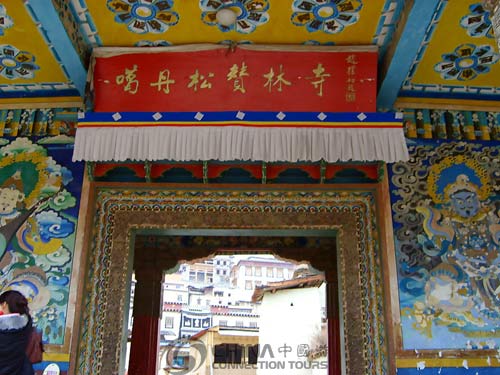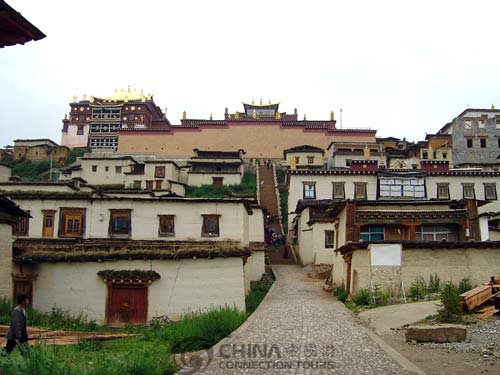
The Gedan Songzanlin Lamasery is four kilometres north of the county and has a long history. The architecture is magnificent; it faces north and is built along the mountains. At first sight, it appears to be just in 1681 (the Year of the Iron Cock in the Tibetan calendar). It is said that the Fifth Dalai Lama chose it as the site of the lamasery through divination and named it "Gedan Songzanlin".
 In the 2nd year of Emperor Yongzheng's rule (1724) in the Qing Dynasty, Deqing was brought under the jurisdiction of Yunnan Province, and the lamasery was renamed the "Guihua Lamasery". Occupying an area of over 500 mu, it has strong walls and five gates. The two main lamaseries Zhacang, and Jikang command the highest position in the architectural complex. They are both Tibetan style watchtowers and are surrounded by eight sub-lamaseries and the dormitories or the lamas. In the distance, one can see the gilded copper stupa at the top of the main lamasery. The gilded copper tiles shine eternally in the plateau sunlight. The auspicious animal decorations and flying buttresses show all elements of the Han's temple styles. 108 giant pillars support the main scripture hall lying in the center of the compound. Brightened with numerous butter oil lamps, the hall can hold 1,600 lamas sitting in meditation or chanting the Buddhist scriptures. The 16 colourful pictures hanging high in the lamasery are said to have been painted by renowned lamas with the golden liquid given by the Fifth Dalai Lama. The lamasery has many treasures.
In the 2nd year of Emperor Yongzheng's rule (1724) in the Qing Dynasty, Deqing was brought under the jurisdiction of Yunnan Province, and the lamasery was renamed the "Guihua Lamasery". Occupying an area of over 500 mu, it has strong walls and five gates. The two main lamaseries Zhacang, and Jikang command the highest position in the architectural complex. They are both Tibetan style watchtowers and are surrounded by eight sub-lamaseries and the dormitories or the lamas. In the distance, one can see the gilded copper stupa at the top of the main lamasery. The gilded copper tiles shine eternally in the plateau sunlight. The auspicious animal decorations and flying buttresses show all elements of the Han's temple styles. 108 giant pillars support the main scripture hall lying in the center of the compound. Brightened with numerous butter oil lamps, the hall can hold 1,600 lamas sitting in meditation or chanting the Buddhist scriptures. The 16 colourful pictures hanging high in the lamasery are said to have been painted by renowned lamas with the golden liquid given by the Fifth Dalai Lama. The lamasery has many treasures.
 The most famous ones are the eight gold-covered sculptures of Sakyamuni, fashioned between the time of the Fifth and Seventh Dalai Lamas. In the early Qing Dynasty, the rulers of Lijiang, the Mu Family, presented the lamasery with dozens of bronze sculptures, the "Ganzur" scriptures hand-written in liquid gold, scriptures written on pattra leaves, gold lamps, and many exquisite gilded silver incense burners. Every morning, noon and eve, the solemn toll of the bells and the sound of the drums from the bell and drum towers can be heard several kilometers away. During its prime time, the Songzanlin Lamasery was home to 1,000 lamas. In 1985, the tenth Panchen Lama paid a special visit to the Lamasery.
The most famous ones are the eight gold-covered sculptures of Sakyamuni, fashioned between the time of the Fifth and Seventh Dalai Lamas. In the early Qing Dynasty, the rulers of Lijiang, the Mu Family, presented the lamasery with dozens of bronze sculptures, the "Ganzur" scriptures hand-written in liquid gold, scriptures written on pattra leaves, gold lamps, and many exquisite gilded silver incense burners. Every morning, noon and eve, the solemn toll of the bells and the sound of the drums from the bell and drum towers can be heard several kilometers away. During its prime time, the Songzanlin Lamasery was home to 1,000 lamas. In 1985, the tenth Panchen Lama paid a special visit to the Lamasery.

